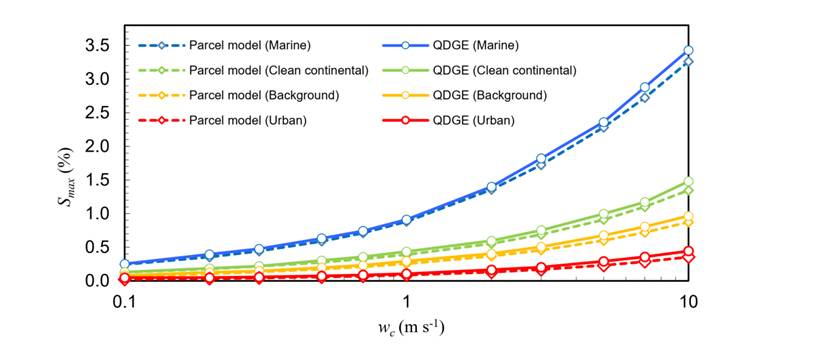According to the Sixth Assessment Report of the Intergovernmental Panel on Climate Change, aerosol-cloud interaction, which plays a dominant role in aerosol climate effect, is also one of the main sources for uncertainties in climate simulation. As this process is subject to the nonlinear complex impacts of several variables, its calculation should be accurately parameterized. The widely used way of parameterization in current models is highly simplified quasi-activation calculation schemes, subject to considerable uncertainties.
A/Prof. Peng Yiran’s Research Group of the Department of Earth System Science (DESS), Tsinghua University, in light of the problems in current cloud droplet activation calculation schemes, and in collaboration with the Canadian Centre for Climate Modelling and Analysis, has proposed the Quasi-steady state approximation of the cloud Droplet Growth Equation (QDGE) scheme, and evaluated the calculation effect of the scheme by using stratus and stratocumulus cloud data sampled during multiple aircraft campaigns in multiple regions around the world. The achievement of this research has been published in a high-level international journal in the field of earth system science, Geoscientific Model Development, as a paper titled “Evaluation of a Quasi-steady state approximation of the cloud Droplet Growth Equation (QDGE) scheme for aerosol activation in global models using multiple aircraft data over both continental and marine environments”.
The major steps of the QDGE scheme are shown in Fig. 1. In this scheme, the change of sub-grid scale in the vertical direction is considered, and the assumption of conservation of cloud water quality and wet static energy is adopted in each sub-grid, and the supersaturation S in the sub-grid is calculated by iterative solution and prior given look-up table. The maximum value of the simulated vertical supersaturation profile, Smax, is then calculated. Consequently, the cloud condensation nuclei number concentration (NCCN) is obtained by integrating the activated aerosol size distribution accordingly.

Fig. 1 A schematic diagram to show the major steps of the QDGE scheme.
Compared with traditional parameterization schemes, the QDGE scheme significantly improves the calculation accuracy for having considered the change of sub-grid scale. The Research Group has compared the results of the gas block model with high-precision numerical solution of the activation process as the reference value, finding that under different aerosol types and vertical velocities, the biases between the results of QDGE scheme and the results of Parcel Model were all within 0.18% (as shown in Fig. 2), decreasing by an order of magnitude compared with the traditional parametric scheme. The QDGE scheme significantly improves the calculation accuracy of the activation process.

Fig. 2 Comparison between the calculated maximum supersaturation (Smax) from the QDGE scheme (solid line) and the parcel model (dashed line).
Additionally, cloud microphysical data observed by aircraft campaigns in different regions worldwide (China, Canada, Chile and Brazil, respectively representing different aerosol types and meteorological conditions in cities, coasts, oceans and clean continents) were used to evaluate the calculation effect of QDGE scheme. The results show that QDGE scheme can effectively simulate the activation process of different aerosol types and different meteorological conditions, and the average of mean relative error values are all below 26 %. Thus the QDGE scheme can effectively improve the applicability and accuracy of cloud droplet activation schemes.
Wang Hengqi, a doctoral candidate of DESS, Tsinghua University, is the first author of the paper. Associate Professor Peng Yiran of DESS and Researcher Knut von Salzen of the Canadian Centre for Climate Modelling and Analysis, are the co-corresponding authors of the paper. Yan Yang, Zhou Wei and Zhao Delong, Senior Engineers of the Beijing Weather Modification Office, are the co-authors of the paper. The research is supported by the Key Research and Development Program of the Ministry of Science and Technology (No.2017YFC1501404) and the National Natural Science Foundation of China (No.42175096, No.41775137 and No.71690243).
Full-text link: https://doi.org/10.5194/gmd-15-2949-2022
Written by Peng Yiran and Wang Hengqi
Edited by Wang Jiayin
Reviewed by Zhang Qiang